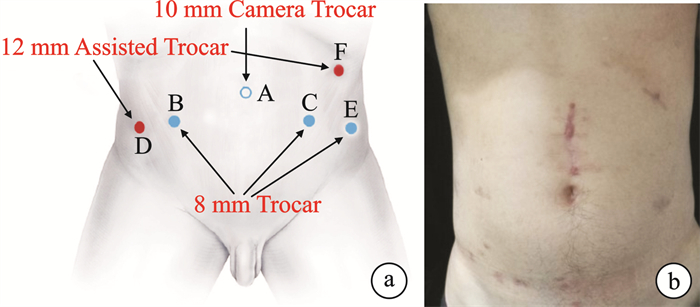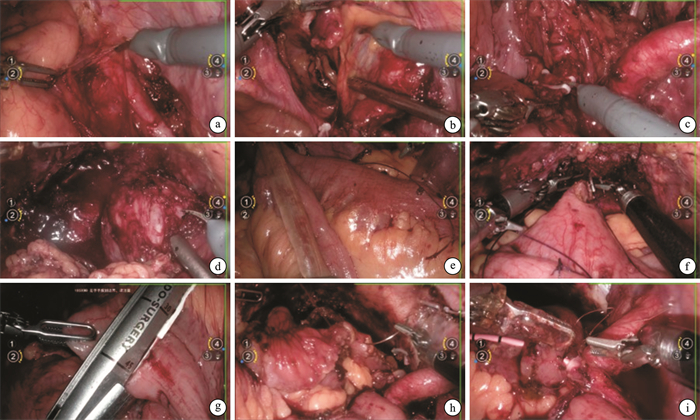Preliminary experience of domestic robot in performing robot-assisted radical cystectomy with intracorporeal urinary diversion
-
摘要: 目的 评价国产图迈机器人在高级别尿路上皮癌患者中进行机器人辅助根治性膀胱切除术和体腔内尿流改道术中的有效性和安全性。方法 纳入2022年10月—2023年5月在浙江大学医学院附属第一医院接受机器人辅助根治性膀胱切除术和体腔内尿流改道术3例患者,其中女1例,男2例,年龄57~70岁。手术包括根治性膀胱切除术和原位回肠新膀胱构建术。结果 所有患者手术均成功,无并发症发生。患者术后状态良好,恢复基本尿控,对整体健康和生活质量满意度较高。国产图迈机器人通过优化人体工程学、增强视觉、降低成本和增加多功能性,使外科医生能够以更高的精确度、准确性和安全性进行手术。结论 国产图迈机器人是未来泌尿外科机器人手术的一个很有前景的工具,具有一定进行远程5G手术的优势和能力。研究结果提示,对于高级别尿路上皮癌患者,机器人辅助体腔内尿流改道术是一种安全有效的治疗选择。Abstract: Objective To evaluate the effectiveness and safety of the Toumai robot in performing robot-assisted radical cystectomy with intracorporeal urinary diversion in patients with high-grade urothelial carcinoma.Methods From Oct. 2022 to May 2023, three patients were included, one female and two males aged between 57 and 70, and underwent robot-assisted radical cystectomy with intracorporeal urinary diversion using the Toumai robot. The surgery involved the radical excision of the bladder and the construction of an in situ ileal neobladder.Results All surgeries were successful with no complications. The patients had favorable postoperative recovery, regaining basic urinary control, and reporting high levels of satisfaction with their urinary control, as well as their overall health and well-being. The Toumai robot demonstrated improved ergonomics, enhanced vision, reduced costs, and increased versatility, allowing the surgeon to perform surgeries with high precision, accuracy, and safety.Conclusion The Toumai robot is a promising tool for the future of robotic urologic surgery, offering several advantages and the capability of performing remote 5G surgery. The study results suggest that robot-assisted radical cystectomy with intracorporeal urinary diversion using the Toumai robot can be a safe and effective treatment option for patients with high-grade urothelial carcinoma.
-
Key words:
- bladder cancer /
- Toumai /
- intracorporeal urinary diversion /
- robotic surgery /
- radical cystectomy
-

-
表 1 患者围手术期基本资料
项目 患者1 患者2 患者3 性别 男 女 男 年龄/岁 70 60 57 体重指数/(kg/m2) 23 22 25 ASA评分 1 1 1 吸烟者 否 否 否 心脏病 否 否 是 糖尿病 否 否 否 临床分期 T1N0M0 T1N0M0 T1N0M0 新辅助化疗 否a) 否 否 术前血红蛋白/(g/dL) 13.6 12.5 14.1 估计失血量/mL 200 100 100 术前肌酐/(μmol/L) 71 85 88 手术时间/min 474 488 443 排便时间/d 3 2 3 恢复规律饮食时间/d 8 7 7 住院时间/d 15 16 12 肿瘤部位 多灶 多灶 多灶 注:ASA为美国麻醉医师协会。a)术前行1次吉西他滨+顺铂(GC)方案化疗。 表 2 病理学资料
病理学 患者1 患者2 患者3 肿瘤部位 多灶 多灶 多灶 肿瘤大小a)/cm 0.5 2.5 6.0 肿瘤生长模式 外生乳头型 外生乳头型 外生乳头型 组织学类型 尿路上皮癌 尿路上皮癌 尿路上皮癌 组织学分级 高级别浸润性 高级别浸润性 高级别浸润性 浸润深度 固有层 黏膜层 黏膜层 脉管内瘤栓 无 无 无 神经侵犯 无 无 无 手术切缘 左输尿管 阴性 阴性 阴性 右输尿管 阴性 阴性 阴性 尿道 阴性 阴性 阴性 淋巴结数量/个 26 28 32 淋巴结转移 无 无 无 Her2 ++ ++ ++ 周围组织侵犯 无 无 无 注:a)如有多个肿块,则采用最大者直径。 -
[1] Sung H, Ferlay J, Siegel RL, et al. Global cancer statistics 2020: GLOBOCAN estimates of incidence and mortality worldwide for 36 cancers in 185 countries[J]. CA Cancer J Clin, 2021, 71(3): 209-249. doi: 10.3322/caac.21660
[2] Claps F, Pavan N, Ongaro L, et al. BCG-unresponsive non-muscle-invasive bladder cancer: current treatment landscape and novel emerging molecular targets[J]. Int J Mol Sci, 2023, 24(16): 12596. doi: 10.3390/ijms241612596
[3] Witjes JA, Bruins HM, Carrión A, et al. European association of urology guidelines on muscle-invasive and metastatic bladder cancer: summary of the 2023 guidelines[J]. Eur Urol, 2024, 85(1): 17-31. doi: 10.1016/j.eururo.2023.08.016
[4] Babjuk M, Burger M, Compérat EM, et al. European association of urology guidelines on non-muscle-invasive bladder cancer(TaT1 and carcinoma in situ)-2019 update[J]. Eur Urol, 2019, 76(5): 639-657. doi: 10.1016/j.eururo.2019.08.016
[5] Contieri R, Hensley PJ, Tan WS, et al. Oncological outcomes for patients with European association of urology very high-risk non-muscle-invasive bladder cancer treated with Bacillus calmette-guérin or early radical cystectomy[J]. Eur Urol Oncol, 2023, 6(6): 590-596. doi: 10.1016/j.euo.2023.07.012
[6] Monteiro LL, Kassouf W. Radical cystectomy is the best choice for most patients with muscle-invasive bladder cancer?opinion: yes[J]. Int Braz J Urol Off J Braz Soc Urol, 2017, 43: 184-187. doi: 10.1590/s1677-5538.ibju.2017.02.03
[7] Tan WS, Lamb BW, Kelly JD. Complications of radical cystectomy and orthotopic reconstruction[J]. Adv Urol, 2015, 2015: 323157.
[8] Lee RK, Abol-Enein H, Artibani W, et al. Urinary diversion after radical cystectomy for bladder cancer: options, patient selection, and outcomes[J]. BJU Int, 2014, 113(1): 11-23. doi: 10.1111/bju.12121
[9] Chang DTS, Lawrentschuk N. Orthotopic neobladder reconstruction[J]. Urol Ann, 2015, 7(1): 1-7. doi: 10.4103/0974-7796.148553
[10] 沈思宏, 曾骁, 彭聊, 等. 原位新膀胱的尿流动力学评估及改善尿控功能的重建技术[J]. 临床泌尿外科杂志, 2023, 38(2): 146-150.
[11] Brodie A, Kijvikai K, Decaestecker K, et al. Review of the evidence for robotic-assisted robotic cystectomy and intra-corporeal urinary diversion in bladder cancer[J]. Transl Androl Urol, 2020, 9(6): 2946-2955. doi: 10.21037/tau.2019.12.19
[12] Vilsan J, Maddineni SA, Ahsan N, et al. Open, laparoscopic, and robotic approaches to treat colorectal cancer: a comprehensive review of literature[J]. Cureus, 2023, 15(5): e38956.
[13] Rivero-Moreno Y, Echevarria S, Vidal-Valderrama C, et al. Robotic surgery: a comprehensive review of the literature and current trends[J]. Cureus, 2023, 15(7): e42370.
[14] Cochetti G, Paladini A, Del Zingaro M, et al. Robot-assisted radical cystectomy with intracorporeal reconstruction of urinary diversion by mechanical stapler: prospective evaluation of early and late complications[J]. Front Surg, 2023, 10: 1157684. doi: 10.3389/fsurg.2023.1157684
-





 下载:
下载:
